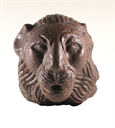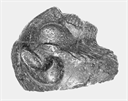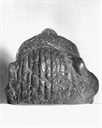Description
This detached lion head is probably from a royal tomb or throne. This head and BZ.1953.6 are nearly identical. Their most striking characteristic is their human appearance, particularly noticeable in the profile view. They were probably carved as part of the support for a royal sarcophagus or a throne.
Bibliography
Handbook of the Dumbarton Oaks Collection, Harvard University (Washington, DC, 1955), no. 55.
J. Deér, The Dynastic Porphyry Tombs of the Norman Period in Sicily, Dumbarton Oaks Studies V (Cambridge, 1959), trans. G. A. Gillhoff, pp. 102-116, figs. 162-169 and 171. Also, see dossier for article by Prof. Deér (prior to his publication).
Handbook of the Dumbarton Oaks Collection, Harvard University (Washington, DC, 1967), no. 42.
D. Glass, "Romanesque in American Collections. V. Washington & Baltimore," Gesta, IX/1, 1970, pp. 47-49, no. 3a-b, and fig. 3-4. Copy in dossier.
G. Vikan, Catalogue of the Sculpture in the Dumbarton Oaks Collection, from the Ptolemaic Period to the Renaissance (Washington, DC, 1995), no. 42, pl. 42a-d. See dossier for prints of comparanda.
W. Cahn, et al., Romanesque Sculpture in American Collections II. New York and New Jersey, Middle and South Atlantic States, the Midwest and Pacific States (New York, 1999), V. The Dumbarton Oaks Collection, p. 117, no. 5.
Acquisition History
Prince Antonin Juritzky, Paris
Mr. and Mrs. Robert Woods Bliss
Gift of Mr. and Mrs. Bliss, March 1953
Harvard University, The Dumbarton Oaks Research Library and Collection, Washington, D.C





